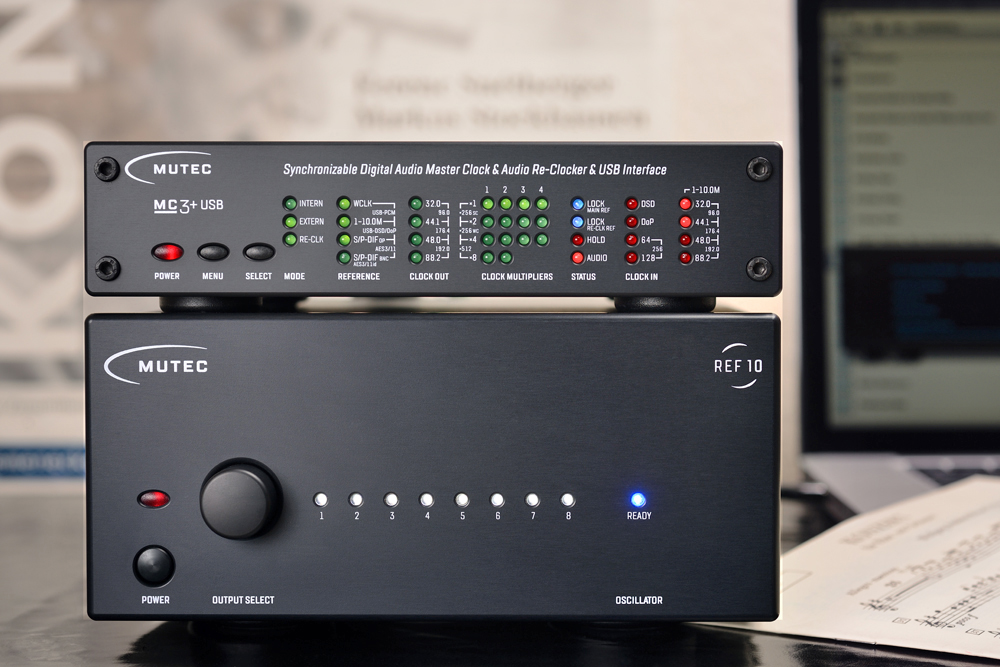While the largest percentage of digital music streamers/players offer a USB output (often as the sole option), many respected engineers strongly accredit either S/PDIF or AES/EBU connectivity as the superior interface between the music source and the downstream digital-to-analogue converter. As with anything audio, this is open to debate. Equally persuasive arguments assert a well-thought-out USB interface can be at least the equal to the alternative transmittance methods. Virtues are often slaves to implementation and both sides of the coin can shimmer with objective and subjective brilliance. So, many highly capable DACs omit a USB input altogether. Conversely, many streamer/players provide that as the only output option. In those applications, a USB to S/PDIF and AES/EBU converter is required. What if said converter is also complimented with a superbly-engineered in-built clocking topology? Further, would a state-of-the-art external Master Clock elevate music enjoyment to even higher levels? Enter the Alpha specimens of the species, the MUTEC MC-3+ USB ‘Reclocker’ and REF10 Reference Master Clock.
Time Will Tell
German company MUTEC specialises in digital interface products of the highest engineering quality with a high penetration and enviable reputation in the Studio and Production space. The company’s sample rate converters, USB interfaces and, of course, its superbly designed Master Clocks have received unequivocal acclaim. Most recently, the benefits of MUTEC’s portfolio have been embraced by audio enthusiasts. The discerning audiophile community has found the company’s superbly engineered components to offer extraordinary value and exceptional performance.
As far as this assignment, testing and assessing both the MC-3+ USB and, subsequently, the REF10 components could present some evaluative challenges (less so the latter as I subsequently discovered). Potentially. In terms of my analysis of their sonic influence once incorporated within the context of my system. In email conversations, the designers of my 432 EVO High-End music player/streamer have strongly asserted the meticulous engineering employed in the design of the USB digital output. They stressed the aim was to provide the best possible playback quality. To this point, the designers looked at every aspect of the digital output possibilities and arrived at omitting all bar the USB option. Among their techniques for optimisation were the employment of a custom clock and substantial dedicated power supply. Similarly, the maker of my DAC of choice, the Totaldac d1-direct, dedicated much attention to its USB input circuitry. The arsenal is well-stocked already.
The MC-3+ USB’s input is asynchronous and fully galvanically isolated. It features MUTEC’s proprietary 10 MHz-ready 1G-Clock technology coupled to the company’s ‘Direct Digital Synthesis’ (DDS) process. Combined, they are said to provide a super-accurate, phase coherent, low-jitter and low-noise digital signal. The MC-3+ USB converts DSD/DoP streams to PCM audio while allowing output clock rate user selection. It can accept up to DSD256 resolutions with Word Clock frequencies up to x512. This is true wide compatibility in terms of resolution capabilities. Of course, the MC-3+ USB can also serve as a wide format converter and digital switcher. To that end, it features a stream of connectivity options (that rear panel is chockers with socketry), with obviously an input for USB supported with AES/EBU XLR, optical Toslink and S/PDIF via coaxial RCA and BNC. Outputs are all of the above (except USB, obviously) plus a variety of word clock ins/outs via BNC.
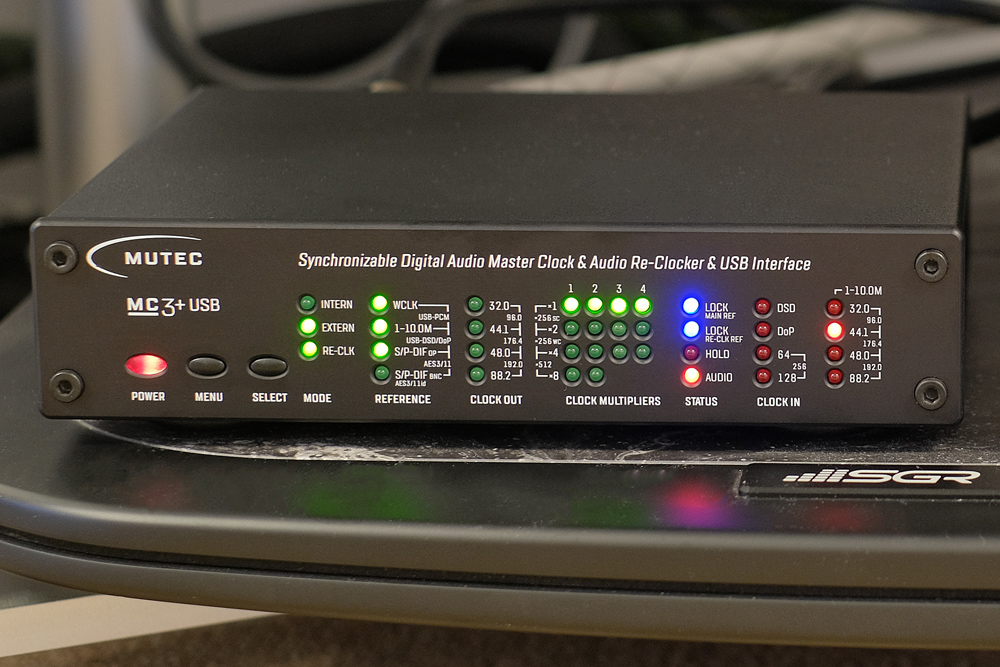
Connecting the MC-3+ USB is straightforward enough. Australian MUTEC distributor ATT Controls’ gracious proprietor Frank Hinton kindly included an additional MUTEC BNC-BNC (proper 75 ohms) cable while I also have in my box of tricks a number of coaxial BNC-RCA and RCA-RCA digital cables and BNC adaptors (native 75 ohms). So it’s a matter of providing the MC-3+ USB with the USB signal and connecting the Word Clock output to my reference Totaldac DAC’s S/PDIF input. I also used the MC-3+ USB as a re-clocker for the S/PDIF signal from my CD transport (Yamaha CD-S2100) in order to evaluate potential benefits as an intermediary re-clocker and subsequent conduit to the DAC.
The one trick that threw me off for a short spell was the fact that the MC-3+ USB required manual switching to ‘Audio’ status – at least it did in the context of my system. I’m told normally the unit should detect signal, lock-it-in and you’re set. I navigated the menus – a matter of pressing the ‘MENU’ button and then cycling through the various options, which are highlighted by an associated LED, via the ‘SELECT’ button – to activate the internal clock and the ‘RE-CLK’ function. I was then ready to rock. I only needed to do this once. The MC-3+ USB silently synched-up with the server and DAC within a split second every time after that. And I powered the unit on/off dozens and dozens of times while in-situ for over two months. Two words: glitchless operation.
Every Second is of Infinite Value – Goethe
As stated above, my 432 EVO High-End streamer/server has had a lot of attention dedicated to its clocking architecture. Feeding its USB output to the MC-3+ USB saw some very subtle changes to the sound. I use the word “changes” because often different is neither better nor worse. It’s just, well… different. I heard a subtle extension to the soundstage depth of spacious recordings such as Ryan Adams’ Ten Songs from Live from Carnegie Hall where there seemed to be a marginal increase in ambience and a larger sense of the venue’s acoustic signature. There may have also been a subtle more ‘twinkle’ in the keyboards, perhaps a little more snap to the steel guitar strings. The noise floor seemed also reduced – that blacker-background-thing audiophiles often refer to.
I confirmed this when playing that champion of live recordings, again from the same iconic venue, with Harry Belafonte’s Live at Carnegie Hall. Belafonte’s wanderings around the stage, his technique of enhancing segments of songs by nearing or distancing from the microphone, played a little clearer with the MC-3+ USB in the system.

Switching to the coaxial S/PDIF output from the CD player proved to be far more conclusive. That marginal enhancement to the soundfield presentation was now noticeably evident. Transient attack, again was enhanced to demonstrate a tighter, more dynamic delivery. On Dirty Three’s Cinder, Warren Ellis’ always incisive violin, especially on the poignant “Sad Sexy” took on a slightly more emotive engagement while the more upfront “The Zither Player” put into more prominence the picked-and-pulled strings at the track’s intro. When the full instrumentation kicks-in, there’s marginally clearer instrument definition and overall separation as the complexity grows.
Ryan Adams’ and Harry Belafonte’s CD versions were also given a good boost in terms of spatial enhancement. Carnegie Hall seemed larger in terms of ambient cues while the stage itself – again, especially on Belafonte’s recording – expanded in terms of depth, most noticeably.
The takeaway goes like this. With a highly-tuned and exceptionally well executed USB implementation, the MC-3+ USB proved a tricky customer to pin down. Improvements were often subtle but, when there and heard, they made a worthy contribution. Conversely, taking the S/PDIF signal from a CD transport evidenced far more wide reaching, meaningful improvements.
Time Isn’t the Main Thing. It’s the Only Thing – Miles Davis
But what of the REF10 Reference Master Clock then? Here is a component which is double the MC-3+ USB’s size. Ditto for the revised dedicated low-noise linear power supply and the enhanced quality of the 10 MHZ clock itself. In addition, the REF10 only performs clocking duties and shuns extraneous functions – it’s a dedicated Master Clock of the highest ilk.
In terms of its functionality, the REF10 is a much simpler device with a shorter list of digital duties. This has allowed MUTEC to dedicate its engineering skills to optimising the specific tasks a reference Master Clock component ought to perform. MUTEC’s dedication to designing the highest-accuracy Master Clock and its associated technologies went as far as recruiting “one of Germany’s most renowned RF engineers to join our R&D team”. The REF10 has been meticulously fine-tuned to provide word accuracy and, while the unit is reference level, MUTEC does offer an even higher-spec, identically-styled Master Clock in the REF10 SE120 which is an expression of the company’s strongest design capabilities.
The REF10 is a workman-like component with a fascia occupied simply by a rotary knob – which acts as the input selector – a power switch with LED in support of the rear’s main AC switch and a bank of LEDs numbered from ‘1’ to ‘8’. A ‘Ready’ LED provides digital sync status. That’s it.
The rear panel features a battery of clock-choice connectivity. It’s populated by a bank of eight BNC output connectors (all galvanically isolated) which, of course, are each coupled to the fascia’s corresponding LED. You’ll also find a ground post and a fused IEC socket.
In the REF10, MUTEC adopts a refined 10 MHz “handcrafted in Germany” OCXO reference clock with what the company claims is the industry’s lowest phase noise. It has enough versatility and inputry to be the reference clock hub for a very comprehensive digital-based system of the highest order. Its high slew rate square wave signal is said to provide superior signal lock precision when compared to sine wave examples of the genre. Said signal is both 50 and 75 ohms compatible, two BNC options for the former and six BNC for the latter, make-up the output options. Selection for clock output is via the fascia’s rotary controller.
The REF10’s dual linear multi-stage power-line-filtered power supply is substantial and is based around a powerful toroidal transformer made in Germany. A dedicated transformer winding is employed as the sole supply to the clock topology. A Panasonic ‘Low ESR’ capacitor bank is said to provide high interference suppression for the supply voltage. MUTEC is particularly proud of the power supply’s vanishingly-low noise and interference properties and supplies a number of graphs to evidence this (check the company’s website, details below).
MUTEC’s design philosophies with respect to reference clock ideologies adopted in the REF10 revolve around the company’s eschewing of rubidium or caesium atomic clocks in favour of a proprietary Oven-Controlled Crystal Oscillator (OXCO). Company head Christian Peters states:
Our research has shown that the high clock stability of so-called "atomic clocks" based on a rubidium or caesium oscillator is limited to the long-term time domain. This long-term stability refers to the amount the absolute clock frequency (10 MHz, or 10 million cycles per second, in this case) drifts over time. While this long-term stability may be useful for some telecommunications applications, it is essentially irrelevant for digital audio purposes. Ultimately, it is the timing from one sample to another as a digital audio stream is transferred from one device to another that needs to be as precise as possible for best sound quality. Fluctuations in short-term stability are measured as jitter or phase-noise and are central to the audiophile performance of any digital audio device. In contrast to these "atomic clocks" then, the REF10 is engineered around MUTEC's handcrafted, oven-controlled oscillator (OCXO) made in Germany, featuring highest clock stability in the time domain relevant for audiophile digital audio performance.
Further, the REF10’s unwavering ability to swiftly lock-in to a digital signal, its vanishingly low levels of jitter and the meticulous control of RFI have all led to several proudly-published graphs showcasing exemplary statistics. To show them all here is not within the scope of this review, however, as suggested above, I recommend visiting the MUTEC website if you’re interested in the technical aspects of this remarkable product (and ditto for the superbly designed MC-3+ USB). Below, a crucial example serves as illustration of what you can expect in terms of measured excellence:
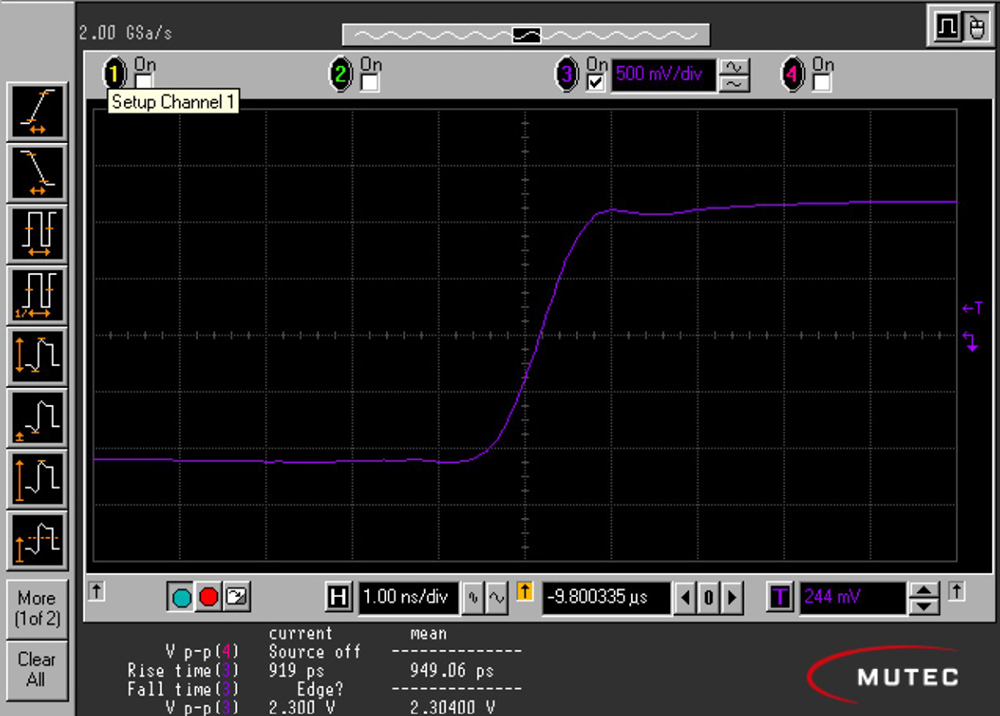
The exceptionally high slew-rate, lowest ripple square wave signal of the REF10
In addition to suggesting the REF10 as an upgrade to any component’s built-in clock, MUTEC also recommends upgrading the MC-3+ USB’s own highly accurate clock by using that unit in conjunction with the REF10. A double whammy actually. I tested it both as a Master Clock to the CD transport and as a further clock architecture to the MC-3+ USB taking a USB feed from the server/streamer. I used both the supplied Mutec BNC-BNC cable and my own very stiff, super-shielded Belden. I didn’t A/B BNC cables because life is just too short. Plus my stock of BNC-terminated cables is… limited. I fed the REF10 with a quality AC cable of my own rather than the generic one supplied with the unit.
It was satisfying to hear the REF10’s contribution to the system’s music-making powers. As stated above, the Totaldac d1-direct is a supremely capable DAC with a very high quality clock of its own. Introducing the REF10 into the signal path showed some complimentary sonic aspects to the overall presentation.
For starters, the soundstage deepened noticeably. Recording permitting, instruments seemed to be located further behind the loudspeakers’ plane. Sometimes, the effect was surprising in terms of creating a very deeply-set mirage. Image positioning was maintained extremely accurately across the sonic field but, as mentioned above, with a deeper spatial perspective. In fact, in my listening notes I made mention of an improved sense of image presence, a more defined outline to instrumental positioning. This of course, is only evident on live recordings such as the ones tested above by Adams and Belafonte and on a couple of in-concert tracks by the-one-and-only Ani DiFranco.
Another observation, although subtler than the soundstage depth noted above, was an increased level of low frequency micro-detail. Bass displayed enhanced textural content, where the bow’s rosin or the double bass’ low resonance contained more nuanced detail and transient information. There was a slightly sharper attack – and that’s saying a lot because in that aspect (and in oh-so-many facets of sonic excellence) the d1-direct DAC is an unparalleled champion. In other words, it’s no mean feat for the REF10 to augment that particular quality.
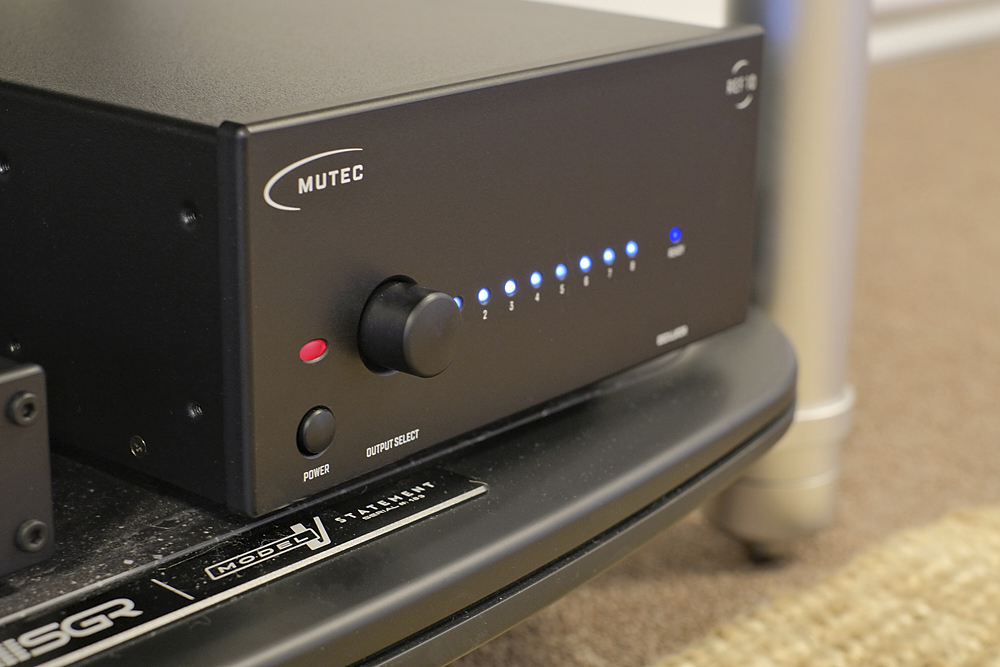
Complex material like large orchestral works such as classics from Beethoven, Holst, Sibelius, Tchaikovsky and others played with excellent balance – the REF10 does not add any digital artifacts and neither does it subtract any musical information. Much appreciated was the REF10’s transparency in terms of tonal quality preservation. Some digital products add a modicum of… etch, or hardness. Not here. The REF10 maintained the textures and timbre signatures of all instruments.
With Stoner Rock faves from Colour Haze, Lowrider, Sasquatch and many others the REF10 showcased superb separation of musical strands and exceptional delineation between vocals and manic rhythm sections (Sasquatch’s “Rational Woman” is a hard, riff-driven wig-flippin’ rocker). Overall, the REF10’s resolving powers of separation, detail and dynamic expression make for exciting music listening.
Enjoyable too were a large selection of Jazz favourites. With Brian Bromberg’s Wood, the REF10 dug the most delicate details from his dexterous handling of the acoustic bass as it did on Victor Wooten’s freakishly-agile playing in A Show of Hands 15. Piano on Trio Elf’s MusicBoxMusic and the track “Emptiness” sounded profoundly quiet and preciously delicate, as it should, while the REF10 preserved the beauty of the instrument in this exquisite recording.
Listening to the REF10 accepting digital signal from the MC-3+ USB carried the qualities of the REF10 without compromise. What I mean is that the MC-3+ USB steps out of the way in terms of its purity in transference of signal, with the REF10 then bringing its excellent properties as the final conduit for the DAC. Despite the additional electronics and the multiple stages of digital manipulation, there’s no corruption to the signal as it’s been relayed.
In parallel to its MC-3+ USB stablemate (and also in conjunction with), it’s worth mentioning again the faultless way in which the REF10 operates. Once synch is established, the unit locked-in without glitch every single time. Whether you powered down from its fascia on/off option or via the main switch in the rear, you can bet your house you’ll have music in seconds. No hiccups, no stumbles. No clicks, no pops.
Conclusion
I enjoy discovering great audio kit which defies pigeon-holing. Sometimes, my audio explorations reveal gear that converges the professional and audiophile spaces. While this playing-in-both-camps has, in the main, been the stuff of loudspeakers, with big companies such as ATC, Bowers & Wilkins, JBL, PMC and Tannoy first coming to mind as the most vivid examples, noteworthy electronics have also excelled in pleasing both the engineer and the audio enthusiast/music lover.
As far as electronics bridging the divide, one of the first examples is dCS, whose digital-to-analogue converters first garnered admiration in recording studios, then becoming the object of desire for well-heeled audiophiles around the world. Interestingly, the company also offers its take on Master Clock technology, albeit at a different price point. Bryston’s amplifiers cut their mustard in studios, and even within the context of touring systems (their reliability and sheer indestructability sees the company offering the biggest warranty in the business), while also becoming a force in the consumer space. And there are many others.
MUTEC joins that elite group of exceptional electronics which cross over offering music-making aptitude whether you’re a studio engineer requiring the best palette of creative tools or a realism-seeking audiophile augmenting the context of a stellar system.
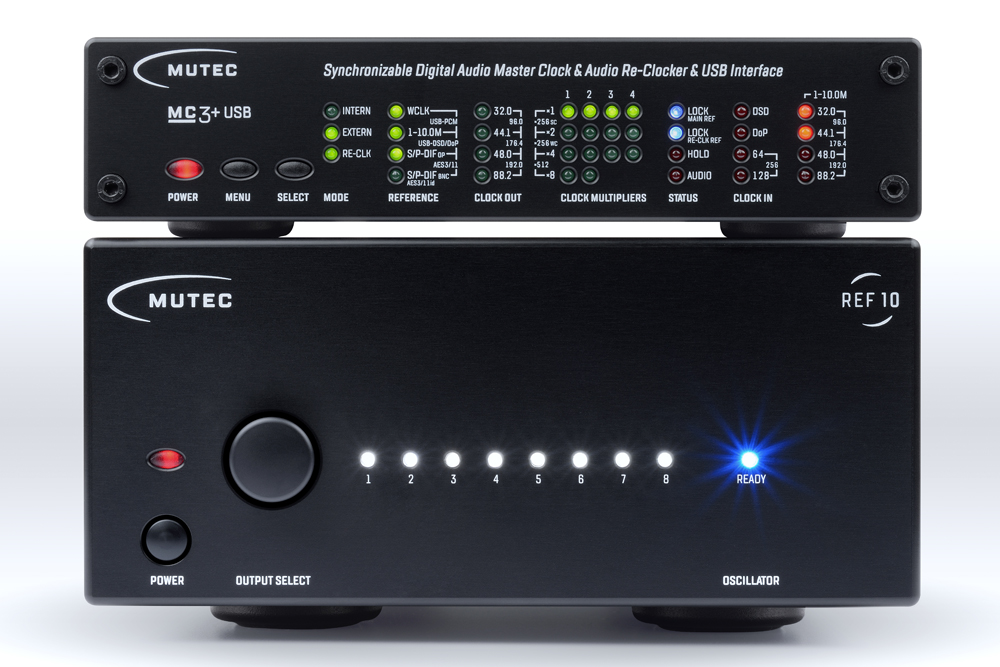
The MC-3+ USB is a superbly engineered component which does not detract from the music while providing faultless operation and a thorough preservation of both the digital signal and the music information contained within it. While its contribution was subtle in the context of my system, that in itself is an achievement. Inserting it into the signal path will not detract, impede nor negatively influence the music in any way. A mid-level streamer/music player, and even many high-end models, which adopt a standard-module USB output, will benefit from the MC-3+ USB’s transparency and neutrality.
The REF10 showed its muscles more overtly and is befitting of the best high-end systems. Again, there were no omissions, degradations or noticeable depreciations from the music. On the contrary, it provided a worthwhile extension to the sonic picture, especially in terms of soundstage depth which stretched further behind the speaker plane. Micro-detail was also somewhat refined and sieved through with purity. Tonal qualities were preserved, in contrast with other add-on digital products I’ve experienced.
So, both the MC-3+ USB Smart Reclocker and the REF10 Reference Master Clock excel at their designated tasks. They are superbly engineered and, despite their austere aesthetic, are extremely well-built. They both feature highly-tuned linear power supplies, bespoke circuit and clock designs and proprietary technologies from a company at the cutting edge of digital electronics engineering.
… Edgar Kramer
This email address is being protected from spambots. You need JavaScript enabled to view it.
Associated Equipment
- Speakers — Wilson Audio Alexia Series 2, Axis Loudspeakers VoiceBox S (nearfield monitor), Vermouth Audio Little Luccas Mk.II
- Amplifier — Gryphon Audio Antileon EVO
- Preamplifier — Supratek Cortese, Lightspeed Attenuator LDR passive
- Sources — Digital: 432EVO High-End Music Server Roon Core, Yamaha CD-S2100 transport, Totaldac d1-direct DAC. Analogue: Transrotor Crescendo with Konstant Studio controller, Reed 1X Tonearm with upgraded internal wiring, Shelter Harmony cartridge, The Funk Firm Houdini cartridge decoupler, Supratek Cortese & REDGUM Audio RGPH2 phono stages
- Processor — DEQX PreMate
- Cables — PSC Audio custom design XLR, Vermouth Audio Reference loom,Vermouth Audio Black Pearl Mk.II loom
- Audio Rack — SGR Audio Statement Model V
- Acoustic Treatment — Vicoustic Multifuser Wood, Wavewood Ultra, Cinema Round Premium and Super Bass Extreme
- Miscellaneous — GigaWatt PF-1 EVO, Les Davis Audio Viscoelastic CLD discs, VRC Vinyl Record Cleaning systemplus miscellaneous accessories
MUTEC MC-3+ Smart USB Reclocker & REF10 Reference Master Clock
Price: AU$2270 and AU$6970
Warranty: Two Years
Australian Distributor: ATT Audio Controls
+61 3 9481 1244
www.attaudiocontrols.com
MUTEC
Siekeweg 6/8
12309 Berlin
Germany
+49 (0) 30 74 68 800
www.MUTEC-net.com







